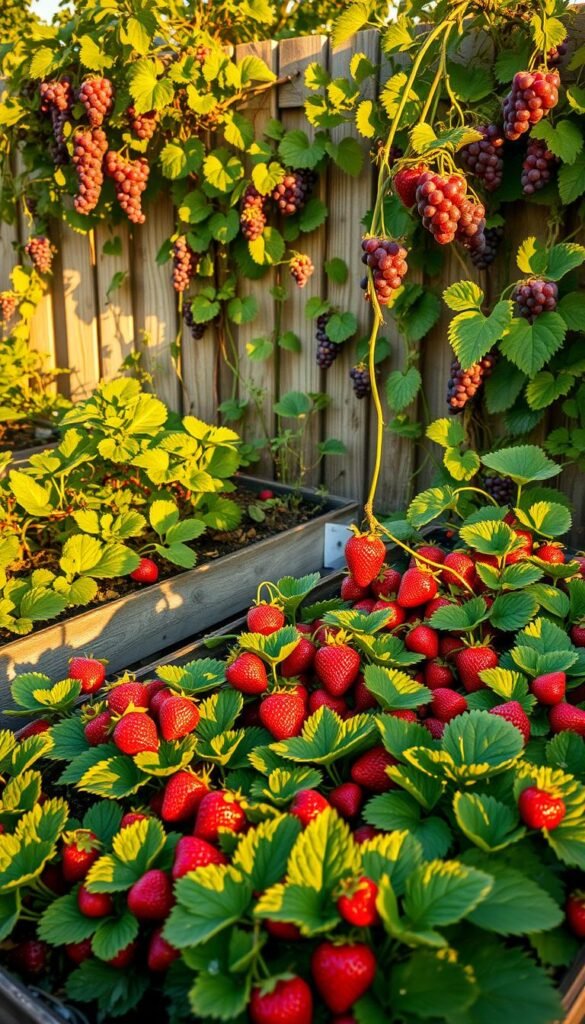Transform your outdoor space into a lush, edible paradise, even if you’re working with limited room. With thoughtful design and modern techniques, you can cultivate sweet strawberries, plump grapes, and other flavorful favorites right at home. The key lies in creative layouts and selecting plants that thrive in your specific conditions.
Vertical gardening opens up possibilities for tight spaces. Imagine strawberries cascading from hanging planters or grapevines climbing a sunny trellis. Compact varieties, like dwarf fruit trees, fit neatly into containers while still producing generous harvests. Pairing these with herbs or flowers not only saves space but also promotes healthier growth through natural pest control.
Self-watering pots and raised beds simplify maintenance, ensuring your plants stay hydrated without constant attention. If you’re exploring edible landscaping, check out our guide to maximizing your harvest in cozy areas. These strategies work beautifully for fruits, too!
Whether you’re tending a patio, balcony, or backyard corner, fresh flavors are within reach. Start with one or two plants, experiment with arrangements, and watch your edible oasis flourish. There’s nothing quite like biting into a sun-warmed berry grown by your own hands.
Planning Your Small Fruit Garden Space
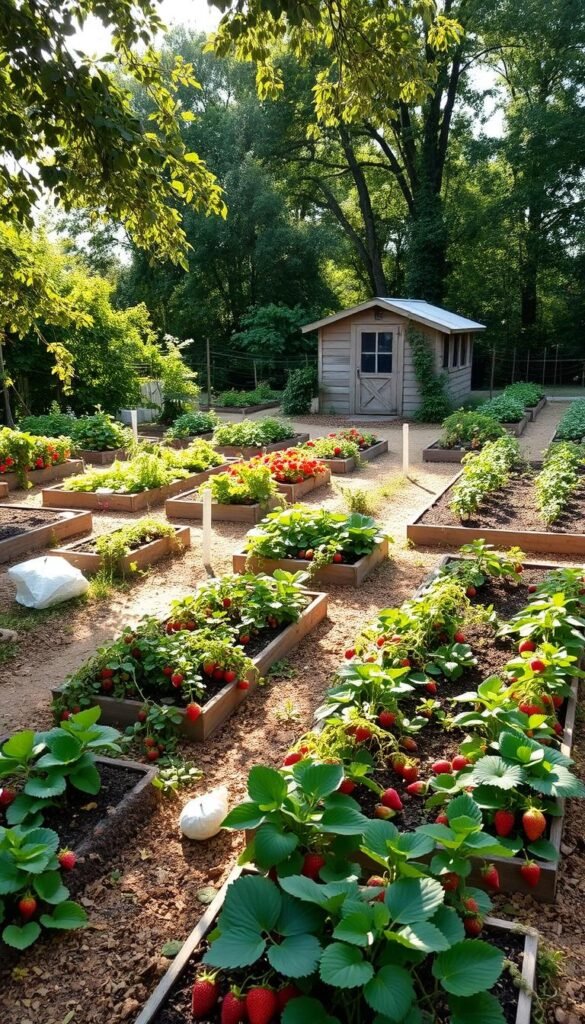
Smart layout choices turn even modest areas into productive growing zones. Before planting, evaluate your ground space and vertical surfaces like fences or walls. This dual approach lets you grow more while keeping pathways clear for care and harvest.
Assessing Your Growing Zones
Grab a tape measure and notebook. Map sunny spots where plants get 6+ hours of light daily. Note shaded areas for crops like currants or gooseberries. Vertical surfaces become prime real estate for climbing varieties when ground space is limited.
Crafting Your Layout
Group plants by sunlight needs and growth habits. Leave 2-3 feet between bushes for air circulation and easy picking.
“Proper spacing prevents disease and boosts yields,”
says urban gardening expert Maria Sanchez. Use containers on patios or stairs to add layers without crowding.
Sketch your design with maintenance paths wide enough for tools. Mix tall trellised plants with low-growing varieties to maximize every inch. This strategic approach transforms your landscape into a living pantry that’s both beautiful and functional.
Small Fruit Garden Inspiration: Clever Ways to Grow Strawberries and Grapes
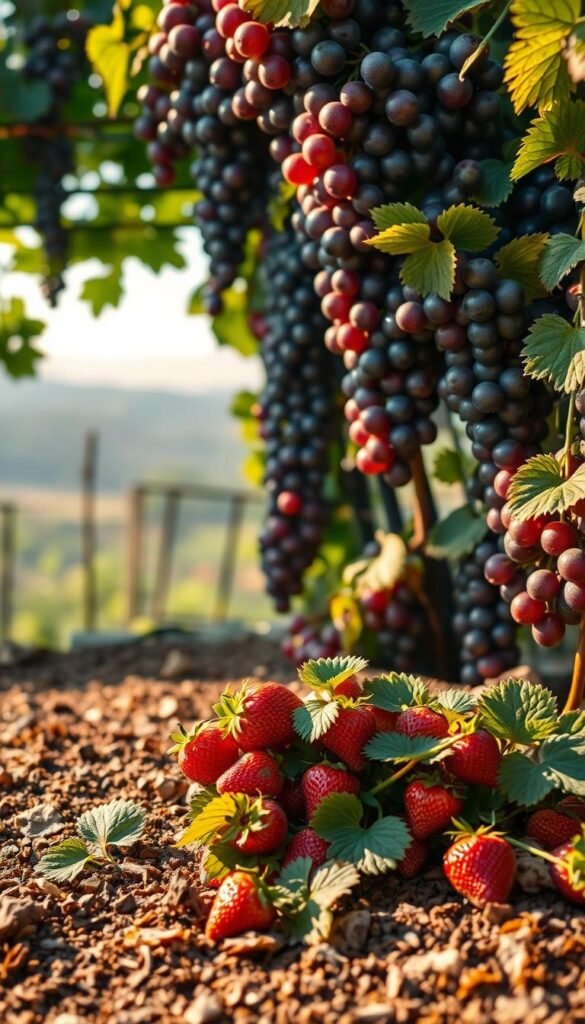
Your garden’s success hinges on working with its natural rhythms rather than against them. Every corner holds distinct conditions that influence plant health and productivity. By tuning into these subtle variations, you create ideal environments for your favorite crops to flourish.
Understanding Your Garden’s Micro-Climate
Sunlight dictates everything. Those juicy red berries crave morning rays and afternoon shade in hotter zones. Position containers where they’ll soak up six hours of direct light while avoiding harsh midday exposure. Grapevines adapt well to various setups but produce sweeter clusters when basking in full sun.
Walls and fences create sheltered pockets perfect for delicate plants. South-facing surfaces radiate warmth, extending growing seasons for heat-loving varieties. North-side areas suit cool-weather crops like alpine strawberries that prefer dappled light.
“Vertical training isn’t just space-saving—it improves air circulation and sun exposure,”
notes viticulturist Liam Carter. Train grape canes along wire systems or lattice panels to boost yields. Pair these with columnar apple trees that grow upward instead of outward, perfect for narrow borders.
Track seasonal changes to stagger harvests. June-bearing varieties deliver a burst of berries early, while everbearing types provide smaller yields throughout summer. Grapes reward patience with late-summer clusters that sweeten as days shorten. Match plant choices to your space’s unique light patterns for nonstop fresh flavors.
Maximizing Vertical Space and Container Gardening
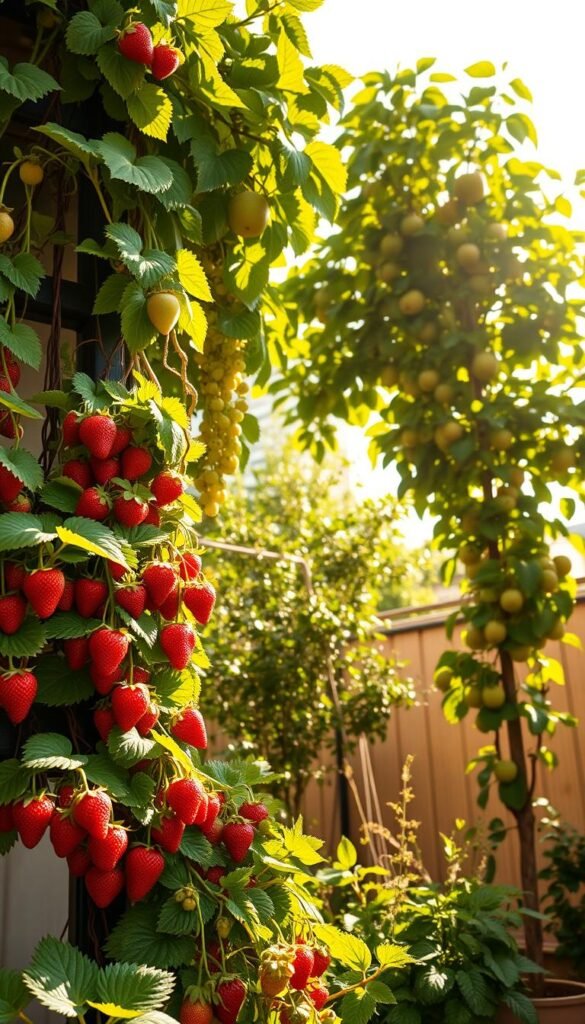
Elevate your harvest potential by looking upward—walls, fences, and vertical structures become prime growing zones when ground space is limited. These solutions merge practicality with eye-catching design, letting you cultivate more while keeping pathways accessible.
Vertical Trellis and Espalier Techniques
Trellises turn blank walls into lush fruit factories. Install cedar or metal frameworks to support climbing varieties like passionfruit or thornless blackberries. For narrow spaces, try espalier—training apple or pear trees into flat, artistic patterns against a fence or wall.
| Material | Best For | Lifespan |
|---|---|---|
| Cedar | Grapes/Kiwis | 7-10 years |
| Metal Grid | Raspberries | 15+ years |
| Bamboo | Annual Vines | 3-5 years |
“Espaliered trees yield 20% more fruit per square foot than traditional orchards,”
Creative Container and Hanging Basket Setups
Hanging baskets bring sweetness to eye level. Line them with coconut fiber to retain moisture, then fill with everbearing strawberries or miniature blueberry bushes. Wall-mounted containers work wonders for compact spaces—attach them to sunny surfaces using rust-proof brackets.
Rotate lightweight pots seasonally to chase sunlight. Pair self-watering containers with drip irrigation for low-maintenance care. For patios, stack terracotta pots vertically to create a tiered berry tower.
Choose resin hanging baskets over clay—they’re lighter and retain moisture better. Add trailing nasturtiums to deter pests naturally while adding pops of color to your edible display.
Crafting Mini Orchards and Edible Borders
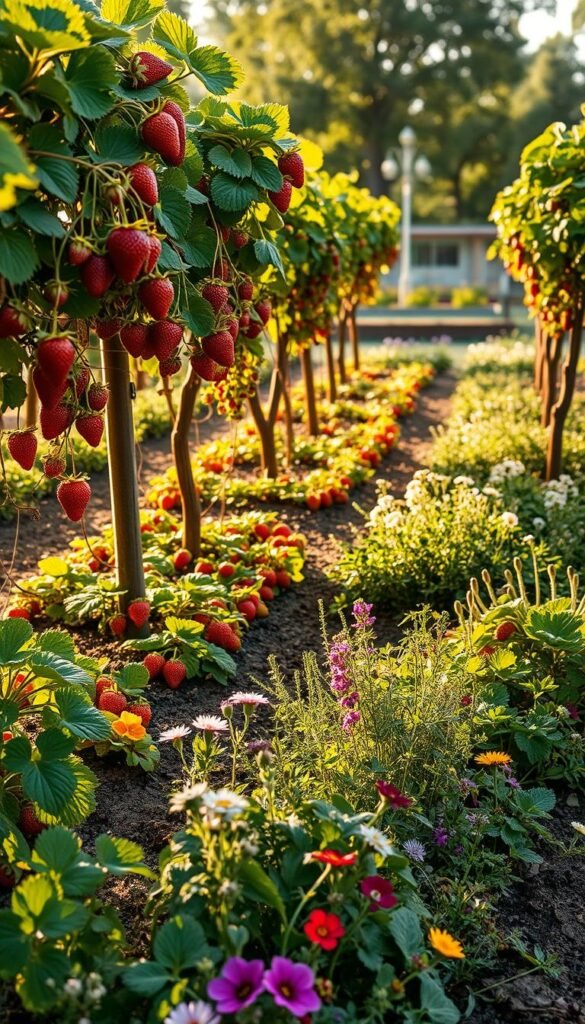
Redefine underused corners by merging beauty with productivity. Compact fruit tree varieties let you establish lush food forests in tight quarters while enhancing your landscape’s visual rhythm.
Building a Mini Orchard with Dwarf Varieties
Space-saving tree selections like columnar apples or genetic dwarf peaches thrive in 8×8-foot plots. Plant three compatible varieties together for guaranteed pollination. This clustering technique mimics natural ecosystems while boosting yields.
| Variety | Pollination Partners | Space Needed |
|---|---|---|
| Dwarf Cherry | Stella, Lapins | 6-8 ft apart |
| Semi-Dwarf Pear | Bartlett, Anjou | 10-12 ft apart |
| Columnar Apple | Urban™ Series | 2-3 ft apart |
“Cross-pollination partners should bloom within 3 weeks of each other for successful fruit set,”
Intermingling Fruit Plants with Edible Border Designs
Weave berry bushes between flowering perennials for dual-purpose beds. Try blueberry shrubs flanked by lavender, or raspberry canes climbing through rose arbors. This approach maximizes every inch while deterring pests naturally.
Time your planting for staggered harvests. Early-bearing currants followed by fall-bearing raspberries keep borders productive. Use dwarf fruit tree cultivars as anchor points, ensuring easy access for pruning and picking.
Layer vertically with espaliered pears above strawberry ground cover. The result? A living tapestry that feeds both body and soul. Remember to leave 18-inch pathways between sections for maintenance without trampling plants.
Integrating Ornamentals with Fruit Plantings
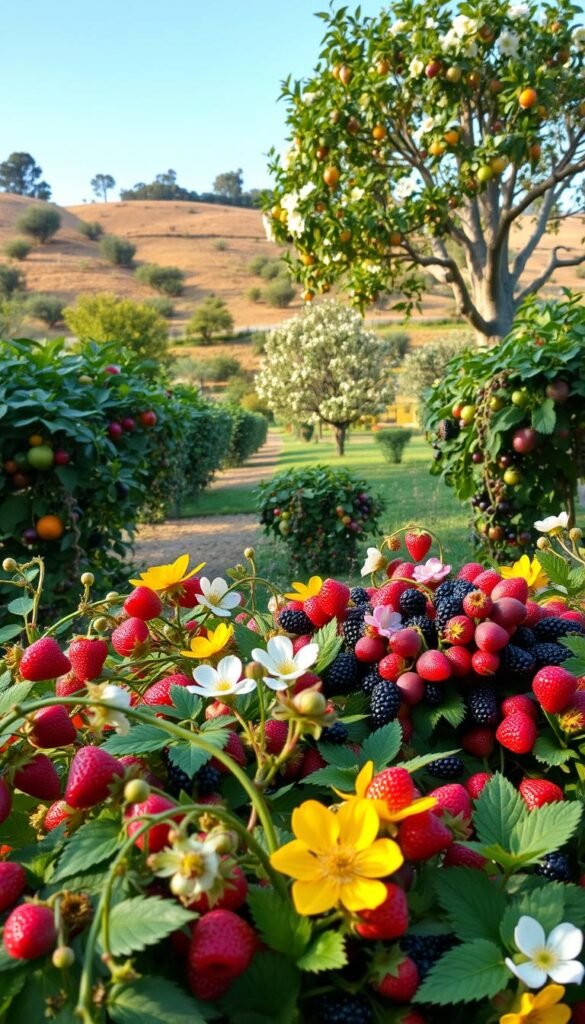
Merge ornamental charm with fruitful harvests by weaving edible plants into your existing landscape. This approach turns every flower bed and pathway into a multi-functional element that delights the eye while filling your basket.
Mixing Flowering Trees with Berry Plants
Start with showstoppers like crabapple or cherry trees. Their spring blossoms create focal points, while summer fruits add practical value. Underplant them with blueberry bushes or strawberry patches for layered productivity.
| Flowering Tree | Berry Companion | Bloom Season | Design Tip |
|---|---|---|---|
| Crabapple | Blueberries | Early Spring | Pair red berries with purple salvia |
| Cherry | Raspberries | Mid-Spring | Use as living fence |
| Redbud | Goji Berries | Late Spring | Contrast heart-shaped leaves |
Time your plantings for continuous color and harvest. Early-blooming serviceberries pair beautifully with fall-bearing raspberries.
“Choose berry varieties that mirror your ornamental shrubs’ growth patterns for seamless integration,”
advises Dr. Rebecca Torres.
For borders, alternate hydrangeas with blackberry canes. The shrubs’ large blooms hide thorny stems while attracting pollinators. In sunny spots, let grapevines climb through rose arbors—their leaves create dappled shade for shade-tolerant berries below.
Remember: successful combinations need matching sunlight needs and root depths. This ensures all plants thrive without competing. Your landscape becomes a living pantry where beauty and bounty grow side by side.
Innovative Strawberry Planter Ideas for Compact Spaces
Turn cramped corners into strawberry goldmines with space-smart growing systems. Whether you’re working with balconies, patios, or narrow side yards, these solutions let you cultivate juicy berries without sacrificing style or square footage.
Vertical Planters and Strawberry Towers
Stack your way to bigger harvests with multi-tiered planters. Repurpose wooden pallets into living walls by lining compartments with landscape fabric and filling them with soil. Old rain gutters mounted on fences create perfect rows for trailing varieties.
| Planter Type | Materials | Plant Capacity | Best For |
|---|---|---|---|
| Tiered Tower | PVC pipes | 20-30 plants | Balconies |
| Gutter System | Aluminum gutters | 12-18 plants | Fences |
| Pallet Wall | Cedar boards | 15-25 plants | Vertical gardens |
“Vertical systems reduce pest damage by keeping fruit off the ground,”
Upcycled Containers and Creative DIY Solutions
Transform everyday items into berry hubs. Drill drainage holes in plastic storage tubs or wooden wine crates for instant pots. Old buckets become charming planters when painted and hung with chains.
Optimizing Raised Beds for Easy Maintenance
Build 12-inch tall beds filled with equal parts compost and potting soil. This depth prevents root crowding while improving drainage. Line paths with gravel to minimize weeds between your sweet harvests.
Expert Tips for Plant Care and Companion Planting
Boost your garden’s productivity by building plant communities that work together. Strategic pairings create natural support systems, reducing pests and improving yields. Start by observing how different species interact in your space.
Implementing Guild Planting for Enhanced Growth
Design guilds around fruit trees using three types of companion plants: nutrient providers, pest deterrents, and pollinator magnets. Legumes like clover fix nitrogen in the soil, while chives repel aphids. Marigolds attract beneficial insects that protect berries.
Use strawberries as living mulch under apple trees. Their shallow roots conserve moisture without competing with deeper tree roots. This approach cuts weeding time by 40% while keeping fruits clean.
Seasonal Care Routines and Maintenance Strategies
Water deeply but less frequently to encourage strong root growth. Check soil dampness 2 inches below the surface—if dry, give plants a slow soak. In summer, refresh mulch layers to regulate temperature and retain moisture.
“A 3-inch straw layer reduces evaporation by 70% compared to bare soil,”
Prune berry bushes after fruiting to promote next year’s growth. Rotate companion plants annually to prevent nutrient depletion. Come fall, add compost to recharge the soil for spring planting.
Wrapping Up Your Fruit Garden Journey
Your journey into cultivating fresh flavors reaches its sweetest chapter here. Through strategic layouts and smart plant choices, you’ve unlocked nature’s potential in every corner. Those juicy Meyer lemons in portable pots? They’re proof that delicious rewards thrive beyond traditional plots.
Vertical systems and container solutions redefine what’s possible. Imagine plucking sun-ripened berries from a wall-mounted planter or harvesting grapes cascading down a balcony rail. These space-smart approaches blend beauty with practicality, turning patios into edible showcases.
The benefits multiply with each season. Pollinators flock to blossoms while you enjoy vitamin-packed snacks steps from your door. Rotate citrus trees to chase sunlight, or mix everbearing varieties for nonstop yields. Every adjustment deepens your connection to the land—no matter its size.
Let this be just the beginning. Experiment with dwarf trees that fit fire escapes or try espaliered pears along fences. Your gardening journey evolves as you discover new ways to harmonize flavor and form. Remember: every inch holds potential when creativity meets nature’s resilience.

